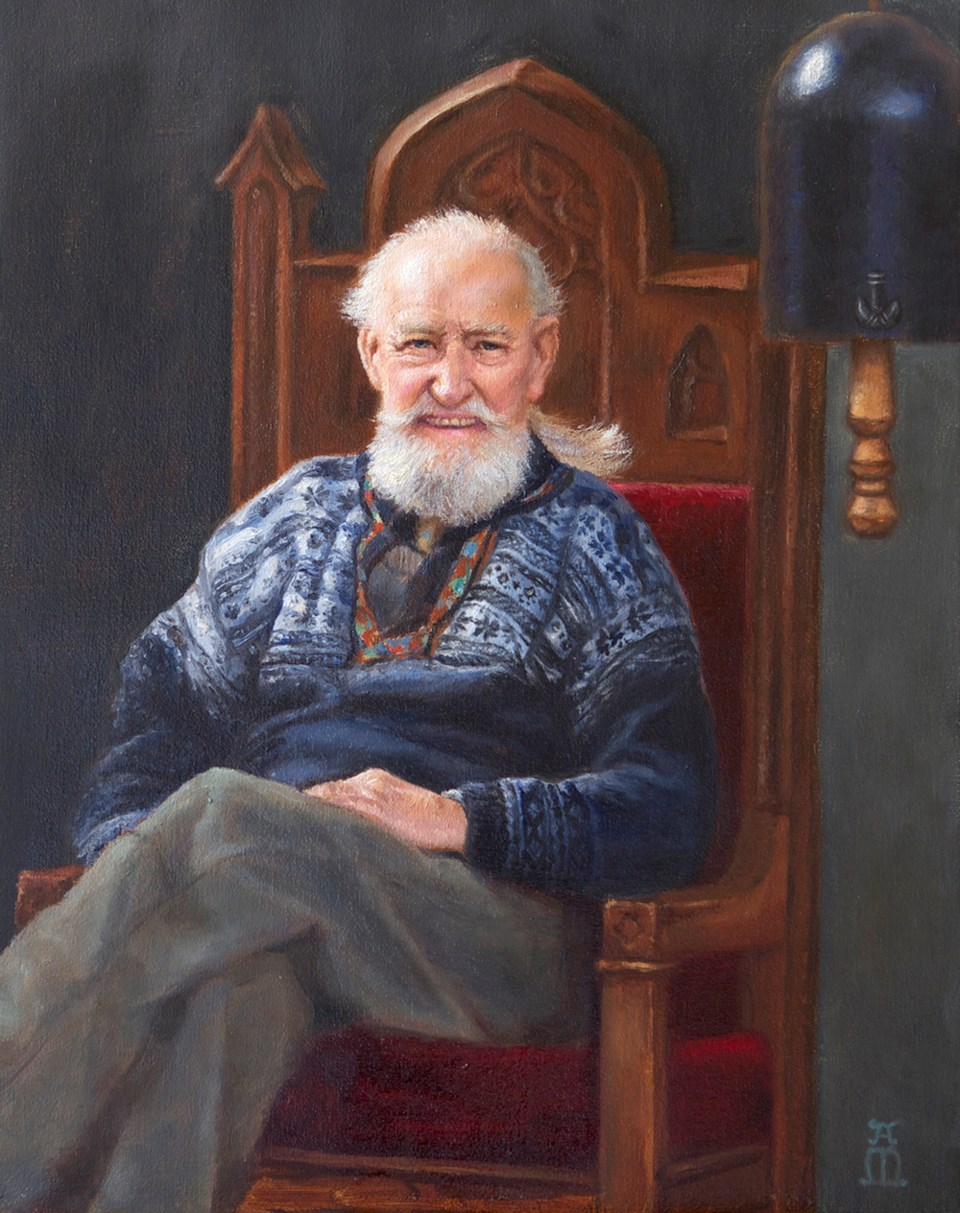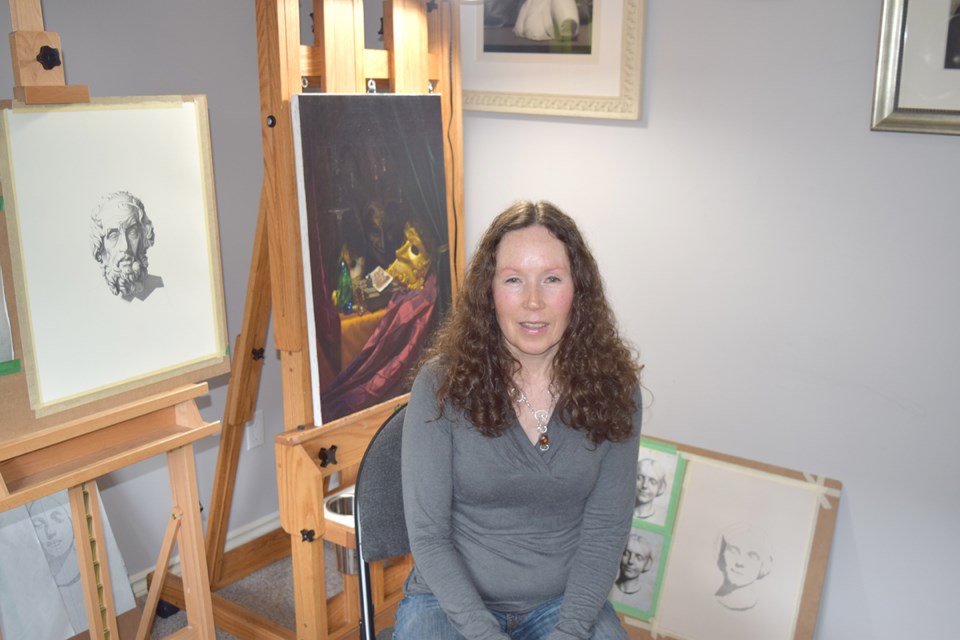It is an oft-repeated cliché that those who suffer in life create better art.
Looking at the stunning and haunting work of Squamish portrait and landscape artist Angela Muellers lends credibility to that saying.
Though she is quick to say that her suffering pales in comparison to others around the world, she has endured more challenges than most.
The Chief sat down with Muellers for a chat at the kitchen table of her bright and cozy Brackendale home that includes the artist studio where she regularly teaches others her craft.
Her townhome is adorned with pieces of her work and the work of a few of her students.
What follows is an edited version of that frank and open conversation that meandered from how she ended up in Squamish, the tragedies she has lived through and the under-appreciated value of art.
Q: What is your history in Squamish?
A: That is a really rough ride. I was a climber and I decided to move here from Vancouver in 2001. It was only a few months later, in June, I was driving down to the city to study with a master painter and a lady crossed the centre line and hit my car. No one thought I was going to survive it. They called my mother to tell her I wasn’t going to live. I had a pretty bad head injury; I had a skull fracture. My face was completely paralyzed on the right side. I was told I was going to lose my right eye, I couldn’t smile, I couldn’t eat properly. It was a rough, rough, rough road. You can still see it a little bit. I can’t quite smile like I used to. But I am not complaining, I am very grateful.
Q: You would think that accident would turn you off wanting to return to Squamish when you healed. Why did you come back?
A: I love it here so much. I have done a fair amount of travelling and I honestly think this is one of the most beautiful places in the world and I love the mountains. The mountains fill my soul. People go to church; I go into the forest and pray. And the rock climbing is amazing. It is kind of like, once your feet leave the ground and you are on the rock you aren’t on the ground anymore and you aren’t in heaven in the sky, you are somewhere in-between. You are somewhere that you have to be really focused – you’ve let go of all your earthly concerns and you are in another place and allowing this magic to happen with your body. I think it is innate in all of us to climb.
Q: You have done so many stunning and hauntingly beautiful portraits that seem to really show the true character of people. How do you have such insight into the human condition?
A: I have endured two tragic family deaths (her sister in 2009 and her life-partner 18 months later) and nearly dying myself in the car accident on the Sea to Sky Highway.
This changed the way I look at life and death and really affected my art. I have personal experience of the temporary nature of our human selves and like to focus on the part of our beings that are eternal when I do a portrait.
Q: Your grandfather inspired you to paint. Tell me about that.
A: My grandfather was from Germany and he was a hobbyist (painter), but my great grandfather was a professional painter and he painted in Paris for some time before becoming an architect. My grandfather, when I was 10 or 11 years old, brought his oil painting kit over and showed my sister and I some oil painting and that really stuck in my mind.
As a teenager I would practice. I went to art school in Victoria. It was an abstract school and it was great to learn about some of the different abstract artists like Mark Rothko, who I absolutely love, and Jackson Pollock, from the 1960s, but I didn’t get any technical training. There were no practical skills taught. I moved to Vancouver and studied and then went to Toronto and finished my studies there. I have gone to school essentially full-time for 10 years and gone to numerous workshops.
Q: Do people commission you to do their portraits?
A: I do sell some pieces and have shown my work quite a bit here, but most of what you see is people I have paid to sit for me. In most of Canada, unfortunately, because there isn’t very much in terms of art training, we aren’t educated on how important art is, and how valuable it is and how much time it takes to do a very high-end portrait; people don’t understand it and people are not willing to pay more than $100 or $200 for a piece of art work. What I see happening in Squamish – not to put anybody down – there are a lot of amateurs who haven’t had any training. So I am competing with people who are selling their work for a few hundred dollars. I should really offer a workshop on how to look at an oil painting and how to tell the difference between a professional and amateur.
For example, if a piece is done on a cheap cotton canvass – I exclusively use linen – it is going to rot much more quickly and it is not going to last as long. If you buy a piece from me, that piece is going to last for hundreds of years. A surprisingly large number of artists too don’t use artist quality paint; they use student grade and it is a dye and not a pigment.
Q: You teach students here in your gallery. Tell me a bit about that.
A: This style of academic training where you start with drawing copies of drawings and then into casts, charcoal and then oil painting and figure work, that is all a tradition that was started in the 1800s – so that is the system I learned and the system I teach.
It really, really works. I have seven students right now and four are teenagers. I love it.
I believe everyone has exactly the same potential no matter what age you are, no matter what your ability is, because it is all about the effort you put in.
For more on her work go to, www.angelamuellers.com.





